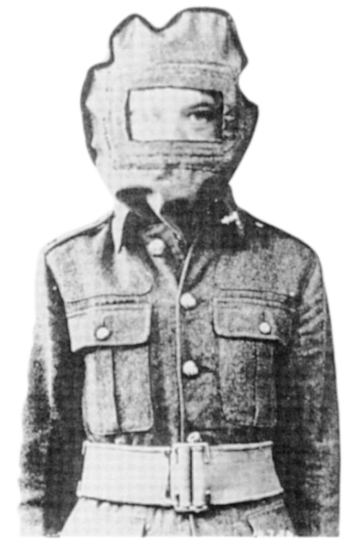America’s first attempt to manufacture gas masks modeled on the British Small Box Respirator (SBR) failed when the mouthpiece was determined to be too large and too stiff and the soda-lime granules in the filter too soft. Improvements resulted in a fuller face-piece, increased dead space, celluloid eye-lenses that tended to fall out, and a tube of anti-dimming paste to prevent condensation. Secured to the head by elastic bands, the masks required the soldier to bite down on the mouthpiece connected to the canister, and, with nose clip attached to his nose, exhale through a rubber flutter valve. One soldier called it “smothering,” the “most torturous thing,” while another described the saliva that flowed from his flutter valves down the front of his uniform. In defense training, special troops wore the mask while constructing roads and digging ditches, and while carrying stretchers through the woods. They played baseball in their masks, walked through gas clouds in their masks. As they tended to breathe deeply at the sound of an alarm, they were first instructed to stop breathing. To sound the alarm, sentries used Strombos, steel triangles, shell casings, and church bells, though later they found Klaxon horns and police rattles most effective.
Although the gas mask originated in materials developed for mining, World War I spurred the mask’s innovation, and the evolution of chemical warfare sped the process. While the Hague Convention of 1899 banned “the use of projectiles the sole object of which is the diffusion of asphyxiating or deleterious gases,” there was no specific restriction on gases released from a pressurized canister, or so claimed Germany in 1915. Only one officer, stationed at Ypres, agreed to deploy the first gas-cloud attack.
Ypres (known now by its Flemish name, Ieper) was not an ideal site. “Seen from a distance the landscape… appears smooth,” one historian of the battlefield writes, “but upon approaching, little undulations, tiny valleys, and minuscule rivulets can be observed.” The hills, as high as eight meters, formed troughs in which the gas might linger, creating potent concentrations capable of impeding a troop advance. The gas might settle in tree branches, too, or in the creases of a trunk. Heavy brush could hold the gas cloud in place.
Meteorologists at the time calculated wind speed at a height of ten meters above the ground. A gas attack, to be effective, worked best when the cloud contoured the earth in its cruel advance. The ideal wind speed for a gas-cloud attack was two to four meters per second, but the wind could change speed or direction, as it...
You have reached your article limit
Sign up for a digital subscription and continue reading all new issues, plus our entire archives, for just $1.50/month.
Already a subscriber? Sign in





